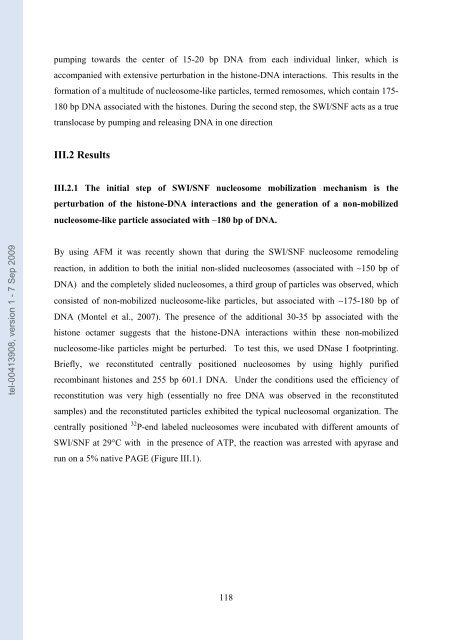Etudes sur le mécanisme de remodelage des nucléosomes par ...
Etudes sur le mécanisme de remodelage des nucléosomes par ...
Etudes sur le mécanisme de remodelage des nucléosomes par ...
Create successful ePaper yourself
Turn your PDF publications into a flip-book with our unique Google optimized e-Paper software.
tel-00413908, version 1 - 7 Sep 2009<br />
pumping towards the center of 15-20 bp DNA from each individual linker, which is<br />
accompanied with extensive perturbation in the histone-DNA interactions. This results in the<br />
formation of a multitu<strong>de</strong> of nuc<strong>le</strong>osome-like <strong>par</strong>tic<strong>le</strong>s, termed remosomes, which contain 175-<br />
180 bp DNA associated with the histones. During the second step, the SWI/SNF acts as a true<br />
translocase by pumping and re<strong>le</strong>asing DNA in one direction<br />
III.2 Results<br />
III.2.1 The initial step of SWI/SNF nuc<strong>le</strong>osome mobilization mechanism is the<br />
perturbation of the histone-DNA interactions and the generation of a non-mobilized<br />
nuc<strong>le</strong>osome-like <strong>par</strong>tic<strong>le</strong> associated with ∼180 bp of DNA.<br />
By using AFM it was recently shown that during the SWI/SNF nuc<strong>le</strong>osome remo<strong>de</strong>ling<br />
reaction, in addition to both the initial non-sli<strong>de</strong>d nuc<strong>le</strong>osomes (associated with ∼150 bp of<br />
DNA) and the comp<strong>le</strong>tely sli<strong>de</strong>d nuc<strong>le</strong>osomes, a third group of <strong>par</strong>tic<strong>le</strong>s was observed, which<br />
consisted of non-mobilized nuc<strong>le</strong>osome-like <strong>par</strong>tic<strong>le</strong>s, but associated with ∼175-180 bp of<br />
DNA (Montel et al., 2007). The presence of the additional 30-35 bp associated with the<br />
histone octamer suggests that the histone-DNA interactions within these non-mobilized<br />
nuc<strong>le</strong>osome-like <strong>par</strong>tic<strong>le</strong>s might be perturbed. To test this, we used DNase I footprinting.<br />
Briefly, we reconstituted centrally positioned nuc<strong>le</strong>osomes by using highly purified<br />
recombinant histones and 255 bp 601.1 DNA. Un<strong>de</strong>r the conditions used the efficiency of<br />
reconstitution was very high (essentially no free DNA was observed in the reconstituted<br />
samp<strong>le</strong>s) and the reconstituted <strong>par</strong>tic<strong>le</strong>s exhibited the typical nuc<strong>le</strong>osomal organization. The<br />
centrally positioned 32 P-end labe<strong>le</strong>d nuc<strong>le</strong>osomes were incubated with different amounts of<br />
SWI/SNF at 29°C with in the presence of ATP, the reaction was arrested with apyrase and<br />
run on a 5% native PAGE (Figure III.1).<br />
118

















